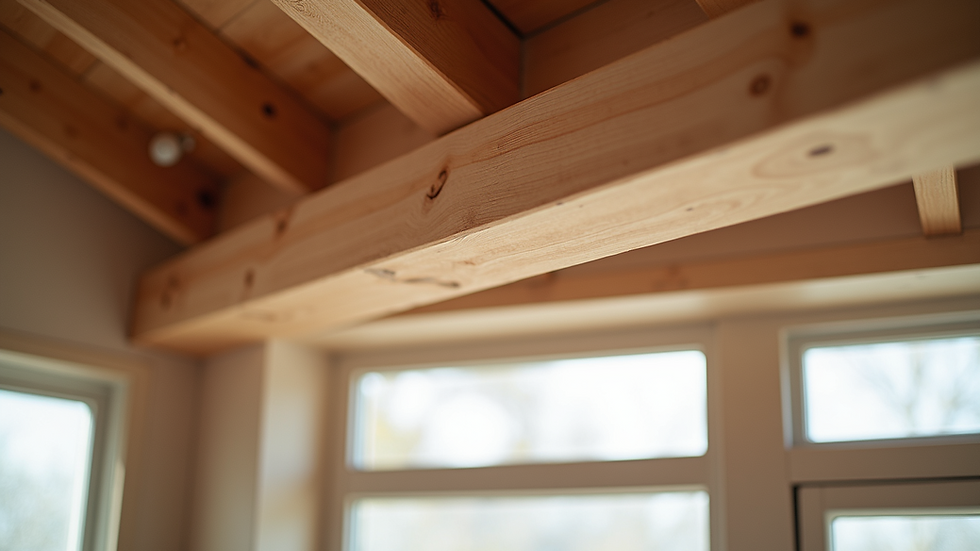Mastering Header Sizing and Installation Techniques for Windows and Doors
- vpirrone8
- Jul 24
- 4 min read
When it comes to framing windows and doors in a building, one of the most crucial elements to ensure structural integrity is the header. Proper sizing and installation of headers over openings can spell the difference between a safe, secure structure and a dangerous flaw. This blog post will cover everything you need to know about header sizing, materials, bearing, lintel height, and best practices for installation.
Understanding Header Sizing
Headers play a pivotal role in distributing loads from above when framed over windows and doors. The concept of header sizing revolves around the calculation of the load-bearing capacity required for a specific span. This involves considering factors such as the size of the opening, the loads from above, and the type of material being used.
To determine the correct size of a header, builders will often use header span charts. These charts provide essential guidelines that help in calculating the size of a header based on the span of the opening and the expected loads.
It’s important to keep in mind that not all headers are created equal. Therefore, understanding the differences between materials such as wood, LVL (Laminated Veneer Lumber), and glulam (glued laminated timber) is essential.
Comparing Header Materials: Wood, LVL, and Glulam
Solid Wood Headers
Traditional wooden headers have been a staple in construction for years. While they are widely available, their load capacity can be limited, and they are more prone to warping and shrinking over time. For smaller openings, however, they can be a feasible option.
LVL Headers
LVL headers, on the other hand, boast impressive strength and stability, making them ideal for larger spans. The manufacturing process of LVL involves bonding thin layers of veneer together, creating a uniform product less likely to warp. They come in various sizes and can be an excellent choice for door openings where significant loads must be supported.
Glulam Headers
Glulam headers present another excellent option. Similar to LVL, glulam is manufactured by gluing together multiple layers of lumber, allowing for greater design flexibility and strength. They are particularly advantageous in situations where aesthetic appeal is a consideration, as glulam beams can be finished beautifully.
Whichever material you choose, ensuring that the appropriate sizing and load calculations are performed is critical.
Proper Header Bearing and Lintel Height
Correct bearing length and appropriate lintel height are paramount for optimal performance. The bearing length is the portion of the header that rests on the supports (walls or columns). Generally, a minimum bearing length of 1.5 inches is recommended, but building codes may vary, so always refer to local regulations.
Lintel height is equally important as it must be sufficient to accommodate the header without allowing excessive deflection under load. Ensuring the lintel height is correct will help maintain the structural integrity of your openings.
Installation Best Practices
Rough Opening Framing
Before installing your header, proper rough opening framing is crucial. The rough opening should be slightly larger than the actual window or door dimensions to allow for adjustments and shimming. A good rule of thumb is to add at least 1/2 inch to the width and height.
Installing Headers: Step-by-Step
Measure and Cut: Accurately measure the opening and cut the header material to the required size, following the guidelines from header span charts.
Position the Header: Place the header on top of the jack studs, ensuring that the ends sit on the king studs securely.
Secure the Header: Use nails or screws to secure the header to the jack and king studs. Don't skimp on fasteners; proper attachment is key to load distribution.
Control Header Deflection: It's important to control header deflection. The amount of deflection allowed is based on the span and load. Ensure you refer to local building codes to know the maximum deflection permitted.
Check Alignment and Level: Once secured, ensure everything is level and aligned before you proceed with the rest of the framing.

Common Mistakes to Avoid
While the process may seem straightforward, common mistakes can compromise the integrity of the header installation.
Ignoring Load Calculations: Always perform load calculations based on the span and use the appropriate size according to header span charts.
Inadequate Bearing Length: Ensure the header has adequate support on each end to avoid sagging and failure.
Using Incorrect Materials: Not all headers work the same in every situation. Familiarize yourself with the properties of LVL, glulam, and wood.
Poorly Executed Rough Openings: Ensure your rough openings are correctly framed for easy installation and adjustments.
Conclusion
Mastering the art of header sizing and installation is crucial for anyone involved in construction or home renovation. Understanding the various materials available, alongside the importance of load calculations and installation practices, will empower you to make informed decisions about framing windows and doors.
By implementing the strategies discussed, from careful measurements to avoiding common mistakes, you can help ensure the strength and durability of your structure. Embrace the skills of structural lintel design and the technicalities involved with engineered header beams, and watch your construction projects flourish.
Whether you choose LVL, glulam, or traditional wood, arming yourself with knowledge only enhances your building expertise. Remember: a strong structure begins with a solid header!

2.png)



Comments